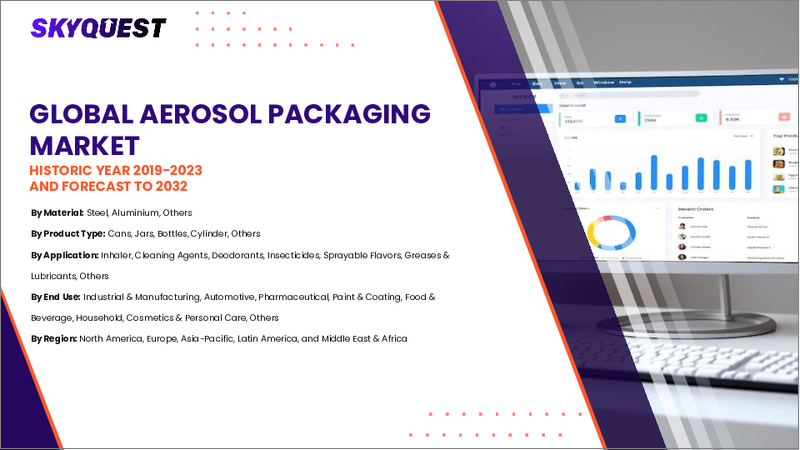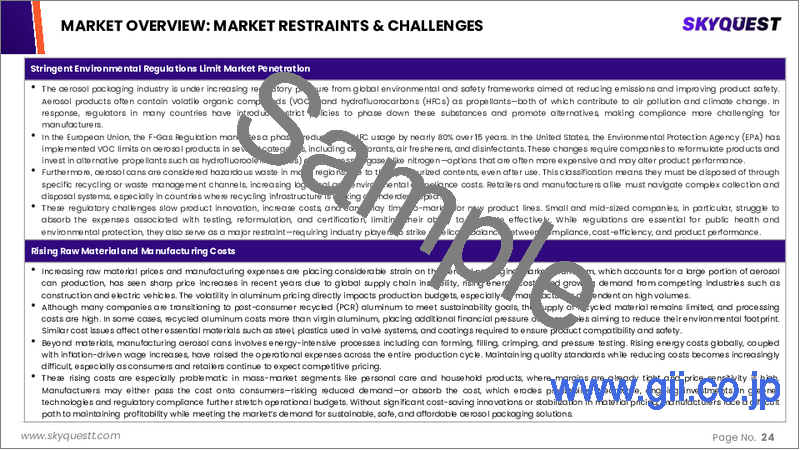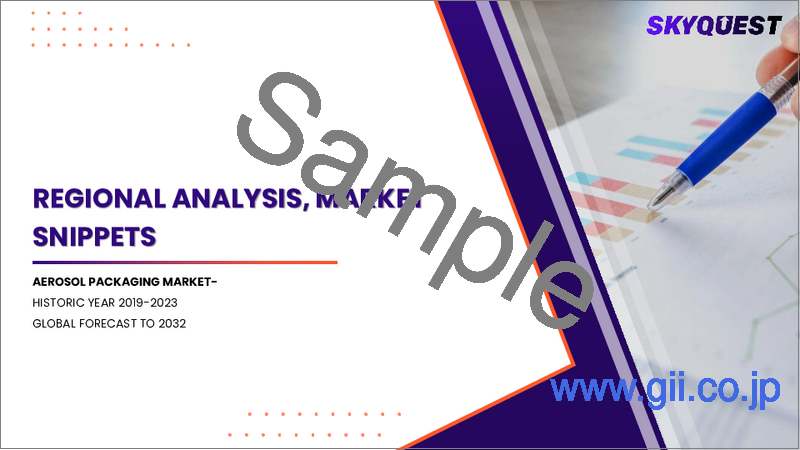|
|
市場調査レポート
商品コード
1789262
エアゾール包装市場の市場規模、シェア、成長分析、材料別、製品タイプ別、用途別、最終用途別、地域別 - 産業予測、2025年~2032年Aerosol Packaging Market Size, Share, and Growth Analysis, By Material (Steel, Aluminum), By Product Type (Cans, Jars), By Application, By End Use, By Region - Industry Forecast 2025-2032 |
||||||
|
|||||||
| エアゾール包装市場の市場規模、シェア、成長分析、材料別、製品タイプ別、用途別、最終用途別、地域別 - 産業予測、2025年~2032年 |
|
出版日: 2025年08月08日
発行: SkyQuest
ページ情報: 英文 192 Pages
納期: 3~5営業日
|
全表示
- 概要
- 目次
エアゾール包装の世界市場規模は、2023年に105億5,000万米ドルと評価され、市場予測期間(2025-2032年)にCAGR 5.84%で成長し、2024年の112億米ドルから2032年には176億4,000万米ドルに成長する見通しです。
エアゾール包装市場は、利便性、衛生、持続可能性に対する消費者の需要の高まりなど、さまざまな要因の影響を大きく受けています。効果的で清潔な調剤を保証する包装を好む消費者が増えているため、パーソナルケア、家庭用品、ヘルスケア分野が力強い成長を示しています。さらに、法規制の圧力により、企業はリサイクル可能な素材や環境に優しい推進剤で技術革新を進め、進化する環境基準やよりクリーンな製品に対する公開会社の期待に沿うようになっています。バルブ機構の改善や、より軽量で耐久性の高い容器の開発などの技術的進歩は、性能と持続可能性をさらに高める。しかし、製造コストの高騰と複雑な製造工程が課題となっているほか、加圧式エアゾール缶に関連する安全性と廃棄の問題もあり、市場の普及と全体的な収益創出の妨げとなっています。
目次
イントロダクション
- 調査の目的
- 調査範囲
- 定義
調査手法
- 情報調達
- 二次と一次データの方法
- 市場規模予測
- 市場の前提条件と制限
エグゼクティブサマリー
- 世界市場の見通し
- 供給と需要の動向分析
- セグメント別機会分析
市場力学と見通し
- 市場概要
- 市場規模
- 市場力学
- 促進要因と機会
- 抑制要因と課題
- ポーターの分析
主な市場の考察
- 重要成功要因
- 競合の程度
- 主な投資機会
- 市場エコシステム
- 市場の魅力指数(2024年)
- PESTEL分析
- マクロ経済指標
- バリューチェーン分析
- 価格分析
エアゾール包装市場規模:材料別& CAGR(2025-2032)
- 市場概要
- 鋼鉄
- アルミニウム
- その他
エアゾール包装市場規模:製品タイプ別& CAGR(2025-2032)
- 市場概要
- 缶
- 瓶
- ボトル
- シリンダー
- その他
エアゾール包装市場規模:用途別& CAGR(2025-2032)
- 市場概要
- 吸入器
- クリーナー
- デオドラント
- 殺虫剤
- スプレー可能なフレーバー
- グリースと潤滑剤
- その他
エアゾール包装市場規模:最終用途別& CAGR(2025-2032)
- 市場概要
- 産業
- 自動車
- 医薬品
- 塗料とコーティング
- 食品・飲料
- 家庭用品
- 化粧品・パーソナルケア
- その他
エアゾール包装市場規模:地域別& CAGR(2025-2032)
- 北米
- 米国
- カナダ
- 欧州
- ドイツ
- スペイン
- フランス
- 英国
- イタリア
- その他欧州地域
- アジア太平洋地域
- 中国
- インド
- 日本
- 韓国
- その他アジア太平洋地域
- ラテンアメリカ
- ブラジル
- その他ラテンアメリカ地域
- 中東・アフリカ
- GCC諸国
- 南アフリカ
- その他中東・アフリカ
競合情報
- 上位5社の比較
- 主要企業の市場ポジショニング(2024年)
- 主な市場企業が採用した戦略
- 最近の市場動向
- 企業の市場シェア分析(2024年)
- 主要企業の企業プロファイル
- 企業の詳細
- 製品ポートフォリオ分析
- 企業のセグメント別シェア分析
- 収益の前年比比較(2022-2024年)
主要企業プロファイル
- Ardagh Group(Luxembourg)
- Ball Corporation(USA)
- Crown Holdings, Inc.(USA)
- Trivium Packaging(Netherlands)
- CCL Industries Inc.(Canada)
- AptarGroup, Inc.(USA)
- Silgan Holdings Inc.(USA)
- Colep(Portugal)
- Valois(France)
- Lindal Group(Germany)
- Guala Dispensing(Italy)
- Mitani Valve Co., Ltd.(Japan)
- Fumakilla Ltd.(Japan)
- Exal Corporation(USA)
- Montebello Packaging Inc.(Canada)
- Nampak Ltd.(South Africa)
- Bharat Containers(India)
- Alucon Public Company Limited(Thailand)
- Allied Cans Limited(Canada)
- DS Containers, Inc.(USA)
結論と提言
Global Aerosol Packaging Market size was valued at USD 10.55 Billion in 2023 and is poised to grow from USD 11.20 Billion in 2024 to USD 17.64 Billion by 2032, growing at a CAGR of 5.84% during the market forecast period (2025-2032).
The aerosol packaging market is significantly influenced by various factors, including heightened consumer demand for convenience, hygiene, and sustainable practices. As consumers increasingly prefer packaging that ensures effective and clean dispensing, personal care, household, and healthcare sectors witness robust growth. Additionally, regulatory pressures drive companies to innovate with recyclable materials and eco-friendly propellants, aligning with evolving environmental standards and public expectations for cleaner products. Technological advancements, such as improved valve mechanisms and the development of lighter yet more durable containers, further enhance performance and sustainability. However, escalating production costs and complex manufacturing processes present challenges, as do safety and disposal issues associated with pressurized aerosol cans, hindering widespread market penetration and overall revenue generation.
Top-down and bottom-up approaches were used to estimate and validate the size of the Global Aerosol Packaging market and to estimate the size of various other dependent submarkets. The research methodology used to estimate the market size includes the following details: The key players in the market were identified through secondary research, and their market shares in the respective regions were determined through primary and secondary research. This entire procedure includes the study of the annual and financial reports of the top market players and extensive interviews for key insights from industry leaders such as CEOs, VPs, directors, and marketing executives. All percentage shares split, and breakdowns were determined using secondary sources and verified through Primary sources. All possible parameters that affect the markets covered in this research study have been accounted for, viewed in extensive detail, verified through primary research, and analyzed to get the final quantitative and qualitative data.
Global Aerosol Packaging Market Segments Analysis
The global aerosol packaging market is segmented by material, by product type, by application, by end-use, and region. Based on the material, the market is segmented into steel, aluminum, and others. Based on the product type, the market is segmented into cans, jars, bottles, cylinders, and others. Based on the application, the market is segmented into inhalers, cleaners, deodorants, insecticides, sprayable flavors, greases & lubricants, and others. Based on end use, the market is segmented into industrial, automotive, pharmaceutical, paint & coating, food & beverage, household products, cosmetics & personal care, and others. Based on the region, the market is segmented into North America, Europe, Asia Pacific, Latin America, and the Middle East and Africa.
Driver of the Global Aerosol Packaging Market
The Global Aerosol Packaging market is significantly driven by the rising consumer demand for convenience and hygiene. Aerosol containers facilitate easy application with a simple press, allowing users to effectively and accurately dispense products while minimizing waste and mess. Their hermetically sealed design ensures that contents remain clean and protected from tampering or leakage, promoting sanitary use and extending shelf life. This combination of user-friendly dispensing and enhanced safety aligns perfectly with modern lifestyles, making aerosol packaging increasingly attractive in sectors such as personal care, food, and pharmaceuticals. The versatility and practicality of aerosol solutions cater to evolving consumer preferences and needs.
Restraints in the Global Aerosol Packaging Market
The aerosol packaging industry faces significant challenges due to elevated manufacturing and operational costs, which stem from substantial capital investments in specialized equipment, high-quality raw materials, and stringent quality control measures. Ongoing expenses related to energy, workforce, and compliance with strict regulations further inflate operational costs, putting pressure on profit margins and hindering market entry for new players. Additionally, fluctuations in the prices of raw materials, particularly metals like aluminum, create financial instability and complicate long-term strategic planning for manufacturers. These financial pressures can slow down innovation and growth, making it increasingly difficult for companies to offer competitive prices while maintaining quality and sustainability standards.
Market Trends of the Global Aerosol Packaging Market
The Global Aerosol Packaging market is witnessing a robust trend towards sustainability and eco-friendly solutions, driven by increasing environmental concerns, stringent regulations, and evolving consumer preferences for recyclable and biodegradable products. Manufacturers are increasingly prioritizing lightweight, refillable, and recyclable materials such as aluminum and post-consumer recycled plastics, while also innovating low-impact propellants and biodegradable coatings to minimize ecological impact. Furthermore, regulatory frameworks, including extended producer responsibility initiatives, are urging companies to adopt sustainable practices and invest in circular packaging systems. This shift not only addresses pressing environmental challenges but also enhances brand competitiveness as sustainability becomes a key factor in consumer purchasing decisions and market positioning.
Table of Contents
Introduction
- Objectives of the Study
- Scope of the Report
- Definitions
Research Methodology
- Information Procurement
- Secondary & Primary Data Methods
- Market Size Estimation
- Market Assumptions & Limitations
Executive Summary
- Global Market Outlook
- Supply & Demand Trend Analysis
- Segmental Opportunity Analysis
Market Dynamics & Outlook
- Market Overview
- Market Size
- Market Dynamics
- Drivers & Opportunities
- Restraints & Challenges
- Porters Analysis
- Competitive rivalry
- Threat of substitute
- Bargaining power of buyers
- Threat of new entrants
- Bargaining power of suppliers
Key Market Insights
- Key Success Factors
- Degree of Competition
- Top Investment Pockets
- Market Ecosystem
- Market Attractiveness Index, 2024
- PESTEL Analysis
- Macro-Economic Indicators
- Value Chain Analysis
- Pricing Analysis
Global Aerosol Packaging Market Size by Material & CAGR (2025-2032)
- Market Overview
- Steel
- Aluminum
- Others
Global Aerosol Packaging Market Size by Product Type & CAGR (2025-2032)
- Market Overview
- Cans
- Jars
- Bottles
- Cylinder
- Others
Global Aerosol Packaging Market Size by Application & CAGR (2025-2032)
- Market Overview
- Inhaler
- Cleaners
- Deodorants
- Insecticides
- Sprayable Flavors
- Greases & Lubricants
- Others
Global Aerosol Packaging Market Size by End Use & CAGR (2025-2032)
- Market Overview
- Industrial
- Automotive
- Pharmaceutical
- Paint and Coating
- Food and Beverage
- Household Products
- Cosmetics & Personal Care
- Others
Global Aerosol Packaging Market Size & CAGR (2025-2032)
- North America (Material, Product Type, Application, End Use)
- US
- Canada
- Europe (Material, Product Type, Application, End Use)
- Germany
- Spain
- France
- UK
- Italy
- Rest of Europe
- Asia Pacific (Material, Product Type, Application, End Use)
- China
- India
- Japan
- South Korea
- Rest of Asia-Pacific
- Latin America (Material, Product Type, Application, End Use)
- Brazil
- Rest of Latin America
- Middle East & Africa (Material, Product Type, Application, End Use)
- GCC Countries
- South Africa
- Rest of Middle East & Africa
Competitive Intelligence
- Top 5 Player Comparison
- Market Positioning of Key Players, 2024
- Strategies Adopted by Key Market Players
- Recent Developments in the Market
- Company Market Share Analysis, 2024
- Company Profiles of All Key Players
- Company Details
- Product Portfolio Analysis
- Company's Segmental Share Analysis
- Revenue Y-O-Y Comparison (2022-2024)
Key Company Profiles
- Ardagh Group (Luxembourg)
- Company Overview
- Business Segment Overview
- Financial Updates
- Key Developments
- Ball Corporation (USA)
- Company Overview
- Business Segment Overview
- Financial Updates
- Key Developments
- Crown Holdings, Inc. (USA)
- Company Overview
- Business Segment Overview
- Financial Updates
- Key Developments
- Trivium Packaging (Netherlands)
- Company Overview
- Business Segment Overview
- Financial Updates
- Key Developments
- CCL Industries Inc. (Canada)
- Company Overview
- Business Segment Overview
- Financial Updates
- Key Developments
- AptarGroup, Inc. (USA)
- Company Overview
- Business Segment Overview
- Financial Updates
- Key Developments
- Silgan Holdings Inc. (USA)
- Company Overview
- Business Segment Overview
- Financial Updates
- Key Developments
- Colep (Portugal)
- Company Overview
- Business Segment Overview
- Financial Updates
- Key Developments
- Valois (France)
- Company Overview
- Business Segment Overview
- Financial Updates
- Key Developments
- Lindal Group (Germany)
- Company Overview
- Business Segment Overview
- Financial Updates
- Key Developments
- Guala Dispensing (Italy)
- Company Overview
- Business Segment Overview
- Financial Updates
- Key Developments
- Mitani Valve Co., Ltd. (Japan)
- Company Overview
- Business Segment Overview
- Financial Updates
- Key Developments
- Fumakilla Ltd. (Japan)
- Company Overview
- Business Segment Overview
- Financial Updates
- Key Developments
- Exal Corporation (USA)
- Company Overview
- Business Segment Overview
- Financial Updates
- Key Developments
- Montebello Packaging Inc. (Canada)
- Company Overview
- Business Segment Overview
- Financial Updates
- Key Developments
- Nampak Ltd. (South Africa)
- Company Overview
- Business Segment Overview
- Financial Updates
- Key Developments
- Bharat Containers (India)
- Company Overview
- Business Segment Overview
- Financial Updates
- Key Developments
- Alucon Public Company Limited (Thailand)
- Company Overview
- Business Segment Overview
- Financial Updates
- Key Developments
- Allied Cans Limited (Canada)
- Company Overview
- Business Segment Overview
- Financial Updates
- Key Developments
- DS Containers, Inc. (USA)
- Company Overview
- Business Segment Overview
- Financial Updates
- Key Developments






